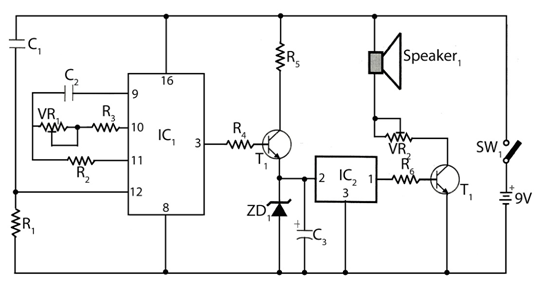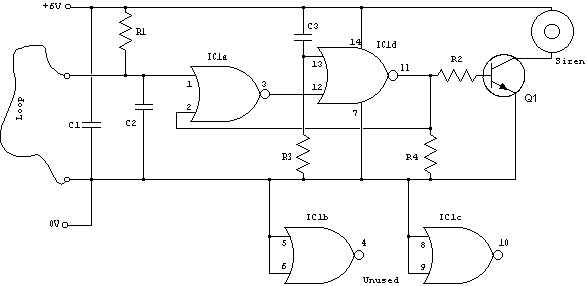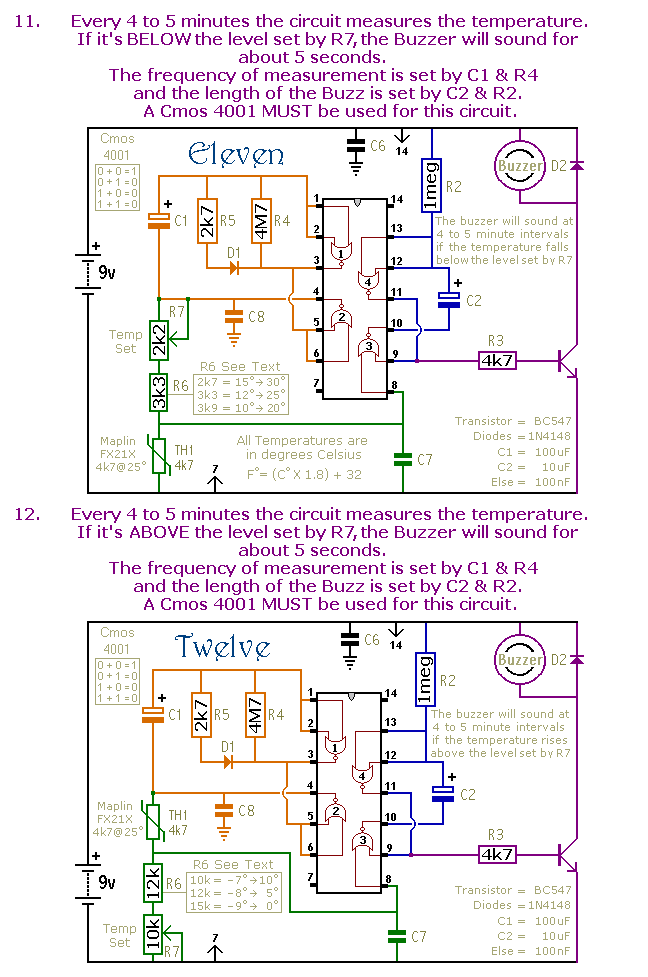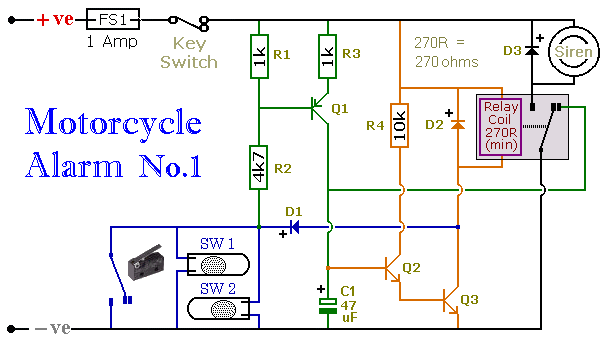
SimpleTimer with Musical Alarm

The circuit timer with a musical alarm utilizes a well-known CMOS oscillator/divider integrated circuit (IC1). Although this circuit operates at 9V, its standby current drain is minimal. The time delay of the timer circuit can be adjusted by modifying the preset variable resistor (VR1). The base of the NPN transistor (T1) is connected to pin 3 of IC1 through resistor R4, while its emitter terminal is connected to pin 2 of the melody generator integrated circuit (IC2) to provide a positive supply once the adjusted time delay has elapsed. A zener diode (ZD1) is employed as a voltage regulator, reducing the power supply to the required operating voltage of IC2, which is 3.3V. The music output from pin 1 of IC2 is sent to a loudspeaker via a driver transistor, with the volume controlled by another preset variable resistor (VR2). To initiate the timer, power is supplied by pressing switch SW1.
The circuit timer with a musical alarm is designed to provide a user-friendly timing solution with an audible output. The core of the circuit is based on a CMOS oscillator/divider (IC1), which generates a precise timing signal. This component is selected for its low power consumption and efficiency, making it suitable for battery-operated applications.
The adjustable time delay feature is facilitated through the use of a variable resistor (VR1), allowing the user to set the desired timing interval. This flexibility is essential for various applications, such as reminders or alerts. The output signal from IC1, once the timing interval has elapsed, triggers the NPN transistor (T1). This transistor acts as a switch, connecting the melody generator IC (IC2) to the power supply, thereby enabling it to produce sound.
The zener diode (ZD1) plays a critical role in voltage regulation, ensuring that IC2 operates within its specified voltage range of 3.3V. This regulation is vital for the stable performance of the melody generator, preventing potential damage from overvoltage conditions.
The melody generator (IC2) is responsible for producing the desired sound output. The audio signal generated from pin 1 of IC2 is amplified by a driver transistor before being sent to a loudspeaker. This amplification is necessary to ensure that the sound is audible, particularly in environments with background noise. The volume control feature, implemented through preset variable resistor (VR2), allows users to adjust the loudness of the output, providing further customization of the alarm's sound.
The circuit is activated by pressing switch SW1, which supplies power to the entire system. This simple user interface ensures that the timer can be easily started with minimal effort. Overall, the circuit timer with a musical alarm offers an efficient, adjustable, and user-friendly solution for timing applications, combining both visual and auditory alerts.The circuit timer with musical alarm use famous CMOS oscillator/divider IC (IC1 ). Although this circuit operates in 9V its standby current drain is very low. The time delay of timer circuit can be adjusted by adjusting the preset VR1. The base of npn transistor T1 is connected to pin 3 of IC1 through resistor R4 and its emitter terminal is connec ted with pin 2 of melody generator IC (IC2) in order to provide positive supply when adjusted time delay is over. Here the zener diode ZD1 is used as regulator which reduce power supply to required for operation of IC2 i.
e. 3. 3V. Lastly for music output the output from pin 1 of IC2 is fed to loud speaker via driver transistor and its volume is controlled by preset VR2. For starting the timer power is supplied by pressing switch SW1. 🔗 External reference
The circuit timer with a musical alarm is designed to provide a user-friendly timing solution with an audible output. The core of the circuit is based on a CMOS oscillator/divider (IC1), which generates a precise timing signal. This component is selected for its low power consumption and efficiency, making it suitable for battery-operated applications.
The adjustable time delay feature is facilitated through the use of a variable resistor (VR1), allowing the user to set the desired timing interval. This flexibility is essential for various applications, such as reminders or alerts. The output signal from IC1, once the timing interval has elapsed, triggers the NPN transistor (T1). This transistor acts as a switch, connecting the melody generator IC (IC2) to the power supply, thereby enabling it to produce sound.
The zener diode (ZD1) plays a critical role in voltage regulation, ensuring that IC2 operates within its specified voltage range of 3.3V. This regulation is vital for the stable performance of the melody generator, preventing potential damage from overvoltage conditions.
The melody generator (IC2) is responsible for producing the desired sound output. The audio signal generated from pin 1 of IC2 is amplified by a driver transistor before being sent to a loudspeaker. This amplification is necessary to ensure that the sound is audible, particularly in environments with background noise. The volume control feature, implemented through preset variable resistor (VR2), allows users to adjust the loudness of the output, providing further customization of the alarm's sound.
The circuit is activated by pressing switch SW1, which supplies power to the entire system. This simple user interface ensures that the timer can be easily started with minimal effort. Overall, the circuit timer with a musical alarm offers an efficient, adjustable, and user-friendly solution for timing applications, combining both visual and auditory alerts.The circuit timer with musical alarm use famous CMOS oscillator/divider IC (IC1 ). Although this circuit operates in 9V its standby current drain is very low. The time delay of timer circuit can be adjusted by adjusting the preset VR1. The base of npn transistor T1 is connected to pin 3 of IC1 through resistor R4 and its emitter terminal is connec ted with pin 2 of melody generator IC (IC2) in order to provide positive supply when adjusted time delay is over. Here the zener diode ZD1 is used as regulator which reduce power supply to required for operation of IC2 i.
e. 3. 3V. Lastly for music output the output from pin 1 of IC2 is fed to loud speaker via driver transistor and its volume is controlled by preset VR2. For starting the timer power is supplied by pressing switch SW1. 🔗 External reference





